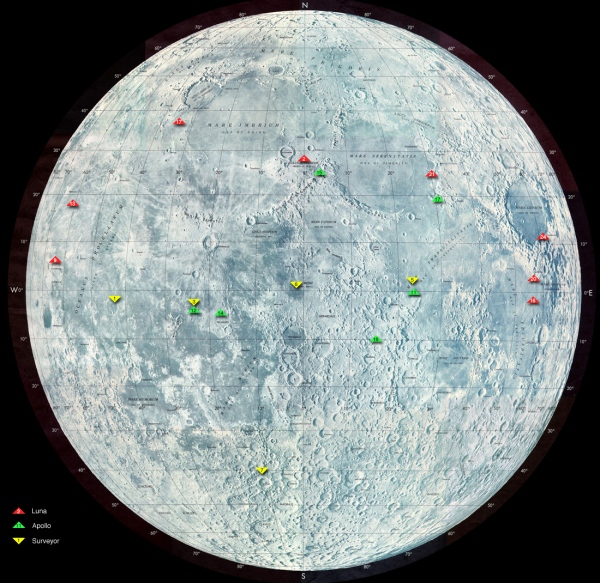
On Feb. 3, 1966 the Soviet Luna 9 spacecraft made the first successful robotic soft landing on the Moon. Seven hours later it transmitted its first images of the lunar surface back to Earth. The image above is Luna 9 lander’s first view—the first time humans had ever seen a picture from the surface of another world.

Launched from Baikonur Cosmodrome on Jan. 31, 1966, the 22-inch-wide (58cm) spherical ALS capsule landed on the Moon at 18:45:30 UTC on February 3, 1966, west of the Reiner and Marius craters in the Ocean of Storms (see the map below of lunar landing sites.) Luna 9 beat America’s Surveyor to the Moon by about four months. Its landing was harder than that of Surveyor, but still soft enough for its camera and radiation detector to survive and do their jobs.
Images were transmitted when solar illumination allowed, seven hours later (technically Feb. 4 UTC). The Soviet Union did not initially share their images with the rest of the world, but England scooped the Soviets by intercepting the radio signals carrying the first photo data and releasing a picture before the USSR produced its official version!
Luna 9 was the 12th attempt at a soft-landing by the Soviets.
In addition to the surface images, perhaps the most important discovery of the Luna 9 mission was establishing that a foreign object would not simply sink into the lunar dust and that the surface of the Moon could support a more massive lander.
Last contact with the spacecraft was at 22:55 UTC on February 6, 1966.

The Soviet Lunar program had 20 successful missions to the Moon and achieved a number of notable lunar “firsts”: first probe to impact the Moon, first flyby and image of the lunar farside, first soft landing, first lunar orbiter, and the first circumlunar probe to return to Earth. The two successful series of Soviet probes were the Luna (24 lunar missions) and the Zond (5 lunar missions). Read more about the Soviet lunar missions here.
Source & credits: NSSDC/NASA Solar System Exploration
Lunar 9 was a great event but at that time I wished the Russians had had a better camera but I am sure that they really didn’t want us to see what the surface really looked like. However the Surveyors with landed really helped us out in determining the lunar soil and it unique materials. At the time of the Lunar 9 landing the Mare lunar surface was believed to be a solid material covered by a dust layer or the Mare surfaces were lava flows covered by a layer of dust. I and the other lunar researchers helped me in developing the Lunar Surface Criteria Document, NASA TMX-5366, created in 1967 that was used in the design of the Lunar Rover for Apollo 15, 16, and 17.
LikeLike
In my comment:the other day :
1 The tex with should have been witch.
2, The TMX is missing the last number which is 1.
3. The date of the TMX is Septeber 28, 1967
LikeLike